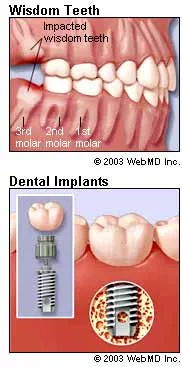Impacted Teeth
Wisdom teeth, otherwise known as third molars, are the last set of teeth to develop. Sometimes these teeth emerge from the gum line and the jaw is large enough to allow room for them, but most of the time, this is not the case. More often, one or more of these third molars fails to emerge in proper alignment or fails to fully emerge through the gum line and becomes entrapped or “impacted” between the jawbone and the gum tissue. Impacted wisdom teeth can result in swelling, pain, and infection of the gum tissue surrounding the wisdom teeth. In addition, impacted wisdom teeth can cause permanent damage to nearby teeth, gums, and bone and can sometimes lead to the formation of cysts or tumors that can destroy sections of the jaw. Therefore, dentists recommend people with impacted wisdom teeth have them surgically removed.
It’s not just wisdom teeth that sometimes become impacted and need to be removed. Other teeth, such as the cuspids and the bicuspids can become impacted and can cause the same types of problems described with impacted wisdom teeth.

Jaw-Related Problems
- Unequal jaw growth. In some individuals, the upper and lower jaws fail to grow properly. This can cause difficulty in speaking, eating, swallowing, and breathing. While some of these problems — like improper teeth alignment — can be corrected with braces and other orthodontic appliances, more serious problems require oral surgery to move all or part of the upper jaw, lower jaw, or both, into a new position that is more balanced, functional, and healthy.
- Improve fit of dentures. For first-time denture wearers, oral surgery can be done to correct any irregularities of the jaws prior to creating the dentures to ensure a better fit. Oral surgery can also help long-term denture wearers. Supporting bone often deteriorates over time, resulting in dentures that no longer fit properly. In severe cases, an oral surgeon can add a bone graft to areas where little bone remains.
- Temporomandibular joint (TMJ) disorders. Dysfunction of the TMJ, the small joint in front of the ear where the skull and lower jaw meet, is a common source of headache and facial pain. Most patients with TMJ disorders can be successfully treated with a combination of oral medications, physical therapy, and splints. However, joint surgery is an option for advanced cases and when the diagnosis indicates a specific problem in the joint.
Other Conditions Treated By Oral Surgery
- Facial injury repair. Oral surgery is often used to repair fractured jaws and broken facial bones.
- Lesion removal and biopsy.Oral surgeons can take a small sample of abnormal growth or tissue and then send it for laboratory testing for identification. Some lesions can be managed medically or can be removed by the oral surgeon.
- Cleft lip and cleft palate repair. Cleft lip and cleft palate result when all or portions of the mouth and nasal cavity do not grow together properly during fetal development. The result is a gap in the lip and/or a split or opening in the roof of the mouth. Oral surgeons work as part of a team of health care specialists to correct these problems through a series of treatments and surgical procedures over many years.
- Facial infections. Pain and swelling in the face, neck, or jaws may indicate an infection. Infections in this area of the body can sometimes develop into life-threatening emergencies if not treated promptly and effectively. An oral surgeon can assist in diagnosing and treating this problem. Surgical treatment, if needed, may include cutting into and draining the infected area, as well as extracting any teeth that might be involved.
- Snoring/sleep apnea. When conservative nonsurgical methods such as positive pressure air machines and dental splint appliances fail to alleviate this problem, surgery can be tried. Surgical procedures involve removing the soft tissues of the oropharynx (an area in the back portion of the mouth) or the lower jaw. Laser surgery is a newer treatment option.

Post a comment